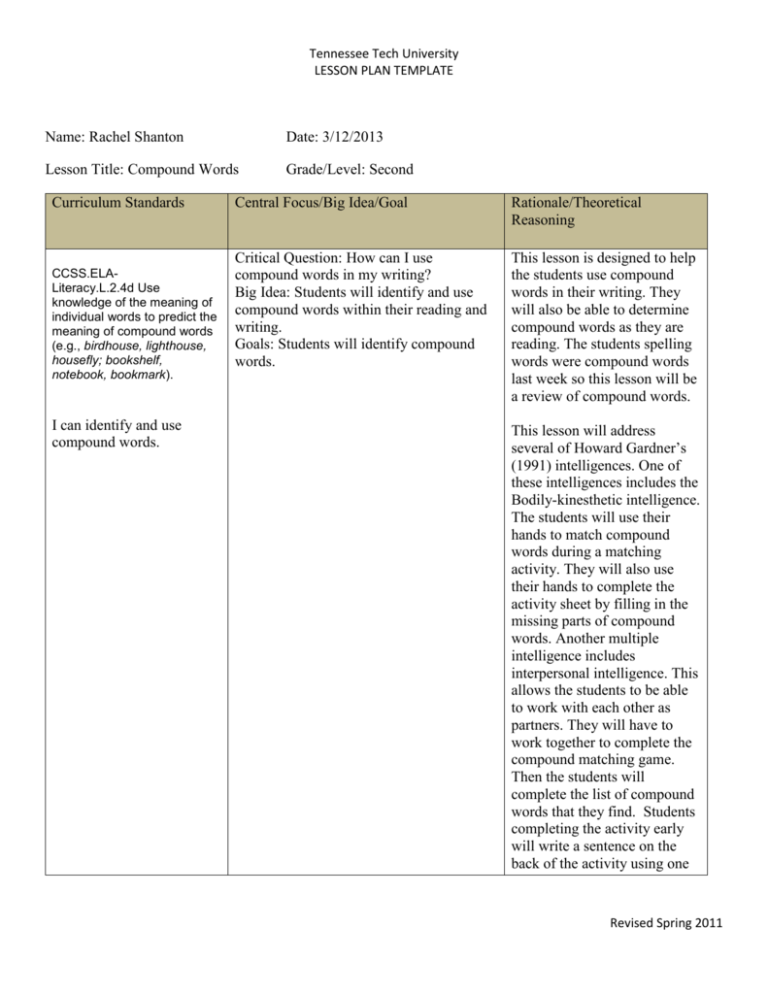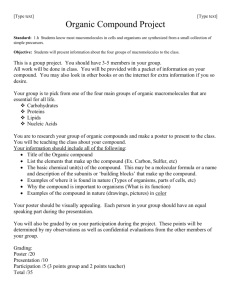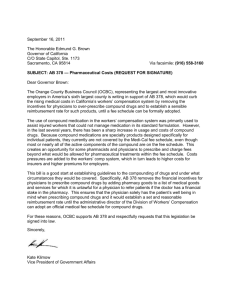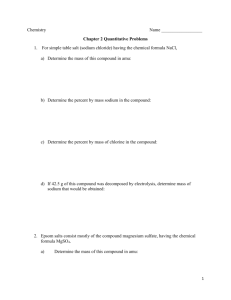Compound Words Leson Plan
advertisement

Tennessee Tech University LESSON PLAN TEMPLATE Name: Rachel Shanton Date: 3/12/2013 Lesson Title: Compound Words Grade/Level: Second Curriculum Standards CCSS.ELALiteracy.L.2.4d Use knowledge of the meaning of individual words to predict the meaning of compound words (e.g., birdhouse, lighthouse, housefly; bookshelf, notebook, bookmark). I can identify and use compound words. Central Focus/Big Idea/Goal Rationale/Theoretical Reasoning Critical Question: How can I use compound words in my writing? Big Idea: Students will identify and use compound words within their reading and writing. Goals: Students will identify compound words. This lesson is designed to help the students use compound words in their writing. They will also be able to determine compound words as they are reading. The students spelling words were compound words last week so this lesson will be a review of compound words. This lesson will address several of Howard Gardner’s (1991) intelligences. One of these intelligences includes the Bodily-kinesthetic intelligence. The students will use their hands to match compound words during a matching activity. They will also use their hands to complete the activity sheet by filling in the missing parts of compound words. Another multiple intelligence includes interpersonal intelligence. This allows the students to be able to work with each other as partners. They will have to work together to complete the compound matching game. Then the students will complete the list of compound words that they find. Students completing the activity early will write a sentence on the back of the activity using one Revised Spring 2011 Tennessee Tech University LESSON PLAN TEMPLATE Lesson Objective(s) o Students will identify compound words. o Students will determine which words are compound words. o Students will apply their knowledge of compound words. Vocabulary/ Academic Language (Language Function) o compound words o identify o determine Assessment/Evaluation Formative: I will ask the students questions throughout the lesson to identify the words that make up the different compound words, and to justify whether a word is a compound word or not. After reading the book, the students and I will complete a Venn Diagram with compound words we found throughout the book. Then students will be paired with a partner. They will complete a matching game with compound words. I will monitor the groups as the students are playing the matching game. Based on their answers, I will be able to identify who needs additional help in mastering the skill. Summative: The students will complete the compound word activity chart and write a sentence using one of the words on the activity chart. Students who correctly complete 80% of the activity chart will be considered mastery. Instruction Set/Motivator: I will ask my students how many of them like mind puzzles? The puzzle for the day would be to find out what these 3 words have in common. (snowman, butterfly, springtime) Instructional Procedures/Learning Task Introduction: I will review with them the meaning of compound words by using examples that show how two words added together make one word. I will read aloud Ladybug Girl and the Bug Squad and students will be listening for compound words as I read. Using a chart Venn Diagram students will create the compound words that were in the story by using the two base words. of the words they found. The last multiple intelligence is intrapersonal intelligence. The students will complete the activity sheet by themselves. They will complete and fill in the missing words in a compound word activity. This will help me know which students may need some additional help with compound words. Lev Vygotsky’s (1896-1934) Interactionist Theory states that children learn through social interaction. The students will be interacting with me, and each other, when I read the book Ladybug Girl and the Bug Squad. We will be identifying some of the compound words in the book. Then we will complete the Venn Diagram activity where we will put compound words together as a group. Jerome Bruner (1950) first introduced the scaffolding theory and it is designed to promote deeper thinking. I am using the compound matching game activity for the students to interact with each other. They will help each other come up with strong sentences. Lev Vygotsky’s (1896-1934) zone of proximal development states that independent problem solving increases with the help of capable peers. The higher students will help the lower students be successful with this Revised Spring 2011 Tennessee Tech University LESSON PLAN TEMPLATE During: Students will work with partners and find matching words that will create compound words. Students will write them on their game charts. If they finish early, students will choose a word and write a sentence using the word correctly. assignment. Palincsar and Brown (1986) developed the concept of reciprocal teaching. This is when the students take the place of the teacher. I used this concept by having the higher students teach the lower students the concept of compound words. Summative: The students will complete an activity chart. They will either have to fill in the first word, second word, or the complete compound word. This will show me which students understand the concept of compound words and which students may still need extra help. Benjamin Bloom (1956) recognizes the use of higher order thinking questions to help students think deeper. He Questions: created a taxonomy of questions that require students How do you know that butterfly is a compound word? to think more. I will include Why is ( ) not a compound word? these H.O.T. questions in my What two words make up playdate? Or use any other compound word lesson to help the students here. How do you know that? fully learn and understand compound words. (*See page Conclusion: 2 for sample questions.) I will have the students repeat the “I can” statement with me one more time. I will ask the students to go around give me a compound word that we learned from the book. Materials: Ladybug Girl and the Bug Squad Venn Diagram Chart Sentence strips to make compound words Matching compound words activity Activity chart Pencil Revised Spring 2011 Tennessee Tech University LESSON PLAN TEMPLATE Adaptations to Meet Individual Needs: Struggling students will be paired with higher students to help with peer tutoring. During summative assessment teacher will circulate to prompt students who may be having difficulty completing assignment. One student sits beside the teacher’s desk. I will place that student with a partner to complete the game Higher order questions will be included throughout the lesson to help high achieving students stretch their thinking. (*See page 2 for sample questions.) Management/Safety Issues: I have only been with this class six times so I am not as familiar with the students as I would like to be. There is one student with ADHD and has trouble sitting still. I will make sure the student sits at the front of the carpet in order to help the student pay attention and stay on task. There are five struggling students so I will place them with higher students for extra guidance. I will also make sure to circulate and check on them throughout the lesson. I will call each group separately to come to the rug to avoid loud noises. I will also have them return to their desks by calling the groups separately. Reflections/Future Modifications: Overall, the lesson went as planned. The students really enjoyed the read aloud book that included the compound words. The students interacted well with each other and were great at volunteering to help put the compound words together on the Venn diagram. The majority of my students mastered the objective of getting 80% of the answers correct on the activity chart. The students really enjoyed the matching game. They all interacted really well with each other. If I were to teach this lesson again I would make to sure to have the students repeat the directions after me so that they all understand what they need to complete. I would also continue to work on my classroom management skills and come up with transitions to use during the lesson so students would know my expectations. __________________________ Student Teacher Signature/Date __________________________ Supervisor/Date Revised Spring 2011 Tennessee Tech University LESSON PLAN TEMPLATE Revised Spring 2011








